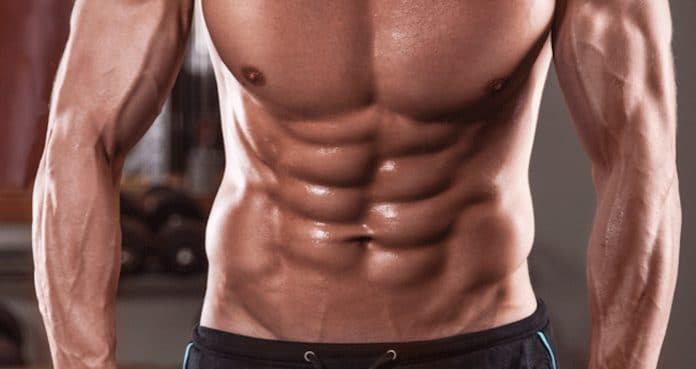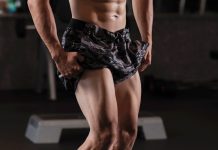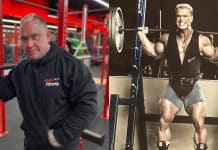
V sits maximize lower ab contraction to help you build the coveted six-pack.
The V-sit is a potent workout targeting your core and trunk muscles. A study encompassing 12 abdominal exercises revealed that the V sit registered the maximum activation for the lower abs (1). Therefore, this exercise could be your go-to routine if you want to chisel a V-taper and craft a six-pack.
You may find V sits challenging if you’re new to V sits. Performing this exercise correctly is crucial to avoid lower back pain. If you’re finding it tough, consider a modified V sit until your muscles gain the strength needed for proper form. This guide will walk you through its variations, enhancing your core strength and form. We’ll introduce you to other fantastic exercises to sculpt your abs.
Techniques & Muscles Worked
The modified V sit works on your internal obliques, external obliques, rectus abdominis, and hip flexors (2). This results in core strength, as it simultaneously hits multiple areas of your torso. The modified V sit can also slightly activate your shoulder muscles, depending on which variation you choose.
To modify the V sit, you can bend your legs or use assistance from your hands. In this exercise guide, we’ll be looking at both. Below are step-by-step instructions for the modified V sit with bent legs.
- First, sit with your legs straight on an exercise mat. This is your starting position.
- Brace your core and then bend your knees at a 90-degree angle.
- Next, raise your bent knees towards your chest and then reach your arms towards your shins.
- Hold this position for several seconds while keeping your spine strong. Don’t round out your shoulders, and ensure you’re not holding your breath.
- Slowly return to the starting position while keeping your abs tight. Pause just before you get to the floor, then hit the floor to complete the rep.
- Repeat for as many reps as you can.
Here are the instructions for the modified V sit with assistance from your arms.
- Sit with your legs straight on an exercise mat, and then lean back onto your elbows. This is your starting position.
- Brace your core and raise your knees with your legs straight towards your chest. Raise your chest to meet your legs while staying on your elbows.
- Hold this position for several seconds, but keep your spine strong and your shoulders not rounded out. Ensure you keep breathing throughout.
- Slowly lower your legs to the floor to return to the starting position. Pause for a second just before you hit the ground.
- Drop to the floor and relax your chest to complete the rep.
- Repeat for multiple reps.
Benefits
Experts often prescribe the V sit exercise for strengthening your abs (3). Modified V sits are easier and help you improve your core muscles to progress to actual V sits. Below are more benefits of this exercise.
Build a Six-Pack
The modified V sit targets your rectus abdominis and obliques very effectively. This builds not only the strength but the size of the muscles there. Your rectus abdominis makes up your six-pack, so after doing this routine, you’ll see some significant changes in how your six-pack looks.
Increase Core Strength
The modified V sit allows you to focus and build a mind-muscle connection when doing V sits. Over time, this will strengthen your core muscles, as proper form is the key to this exercise. The extra support from your hands or bent knees will help keep you on form.
Improve Posture
They work on your core and trunk muscles. These muscles contribute to your posture and the way you carry yourself. Strengthening them with modified V sits can help to improve your posture.
Strengthen Balance & Coordination
V sits require balance and coordination to keep you stable during the exercise. Modified V sits will help you build these by strengthening your core muscles over time. The better you get at doing your V sits unaided, the better your balance and coordination will be.
Functionality
Many core exercises focus on just your abs during training. This is great, but when it isn’t practical functionally. This exercise works on your abs and hip flexors together, which is how they function when carrying out your everyday activities.
Carryover to V Sit & Other Core Exercises
The modified V sit is a progression for doing V sits. However, this exercise can improve form for other core workouts because it strengthens your core muscles.
Modified V Sit Alternatives
Adding a modified V sit to your exercises is excellent for your core. Below are some other good core strengthening exercises you can try out.
Knee Tucks
Knee tucks also primarily focus on your lower abs, like the modified V sit. However, knee tucks also activate your quads and hamstrings. Knee tucks are also functional as they train your abs and hip flexors.
Spiderman Planks
Like knee tucks, spiderman planks are also an effective bodyweight exercise for your core. They, however, also recruit your glutes, triceps, and shoulders. Spiderman planks are also particularly effective because they strengthen your core’s front and back.
Half Sit Ups
Half sit-ups are also core strengthening and target your abs. They improve your posture and balance, too. The half sit up variation places less stress on the lumbar spine than going all the way up as a standard sit up requires.
FAQs
What are modified V sits?
Modified V sits are a way to do V sits with extra support from your arms or legs. This can help you focus on your form, essential for getting results during this exercise.
What are the benefits of modified V sits?
Modified V sits help you do V sits without worrying too much about your balance that you compromise on form. This exercise also still works the same muscles as the regular V sit.
How do I modify a V sit?
You can bend your knees or use your elbows to modify the V sit. In the exercise guide above, you’ll find step-by-step instructions on modifying the V sit both ways.
Follow us on Instagram, Facebook, and Twitter for more fitness exercise guides!
References
- Guimaraes, A. C., Vaz, M. A., De Campos, M. I., & Marantes, R. (1991). The contribution of the rectus abdominis and rectus femoris in twelve selected abdominal exercises. An electromyographic study. The Journal of sports medicine and physical fitness, 31(2), 222–230.
- Seo, J., & Chung, Y. (2020). The effects of different V-sit positions on abdominal muscle activation. Physical Therapy Rehabilitation Science, 9(3), 201–208. https://doi.org/10.14474/ptrs.2020.9.3.201
- Willett, G. M., Hyde, J. E., Uhrlaub, M. B., Wendel, C. L., & Karst, G. M. (2001). Relative activity of abdominal muscles during commonly prescribed strengthening exercises. Journal of strength and conditioning research, 15(4), 480–485.















